The New Wave of Caregiving
by Laura Petrecca, AARP
These cartoonish-looking iPal robots (below) elicited smiles and laughs. Yet, they and their mechanical brethren may soon fulfill a serious mission: keeping those older Americans healthy, active and alert.
Companies around the world are investing in “socially assistive" robots — they assist through social interaction, not physical interaction, and can help with the caregiving concerns of an aging population. From AvatarMind's iPal, which could eventually monitor for falls, and Catalia Health's Mabu, who can ask questions like a nurse, to a plush seal that improves the mood of users, these robotic assistants may be increasingly marketable in a world where caregiver shortages in the U.S. are expected to reach nearly 450,000 by 2025.
Globally, the number of people 60 and older is expected to skyrocket from 962 million in 2017 to 2.1 billion in 2050, according to the United Nations. At the same time, countless people regularly use technology such as smartphones, Google Homes and Amazon Echos to enhance their lives.
“Technology is much more ubiquitous today,” says Cory Kidd, Catalia Health's founder and CEO. “It’s the right place and time to use [robots] like this” to aide the larger community.
Mabu (above), a 15-inch yellow robot with large round eyes is currently focused on helping patients with congestive heart failure, by tracking medications and activity level.
A typical conversation begins with Mabu asking how a person feels. Its queries (both verbal and text on a screen) can then delve into other areas, such as inquiring about someone’s weight or screening for anxiety and depression. The information is then analyzed by Catalia Health, with pertinent data sent to the user’s health care providers.
ElliQ (above) — currently being tested in California by about a dozen people between the ages of 62 and 97 — looks more like a small, modular lamp than a robot. It proactively offers trivia, plays music, suggests educational video lectures and encourages outside walks. It also connects the user with others through video or text and photo messaging.
“The whole goal of ElliQ is to help people stay active and engaged and to be a presence on their side throughout the day,” says Intuition Robotics cofounder and CEO Dor Skuler. After launch, ElliQ will be available to consumers through the company's website and other business-to-consumer channels. (Intuition and Catalia didn’t disclose prices for their
products; the iPal will sell for $2,500.)
Paro (above), a $6,000 interactive baby seal, is another robot that offers emotional support. The plush white device, about the size of a large stuffed animal, responds to stimulants such as touch, noise, light and temperature by moving its head and legs or making sounds. The robot has helped to improve the mood of its users, as well as offers some relief from the strains of anxiety and depression, says inventor Takanori Shibata, a chief senior research scientist at Japan's Human Informatics Research Institute and National Institute of Advanced Industrial Science and Technology (AIST). The 300 Paros in the U.S. are a fraction of the 3,500 found in Japan, a country that has adopted the use of socially assistive robots more rapidly due to its rapidly graying nation.
The U.S. is making advances. The National Institute on Aging has provided more than $1 million in research funding for socially assistive robots. And the market is ripe for investment from others, such as venture capitalists, says Maja J. Matarić, a roboticist and computer science professor at the University of Southern California. “In my experience, elderly users are very open toward trying technology,” she says.
"The goal isn’t to replace humans. It’s about motivating people to help themselves." “The way you live long and stay happy is that you want to get up and do something.”
To read this full article as well as the entire
AARP series featuring Caregiving & Technology:
https://www.aarp.org/caregiving/home-care/info-2018/new-wave-of-caregiving-technology.html?cmp=EMC-DSO-NLC-RSS-CAREGIVING--CTRL-120718-P1-3416913&ET_CID=3416913&ET_RID=36681338&mi_u=36681338&mi_ecmp=20181207_DailyBulletin_Control_247401_320001&encparam=wkysKG5P8%2fXrG29py%2b20OZ%2fGsl2lm6X5g3df6nxsIu4%3d




